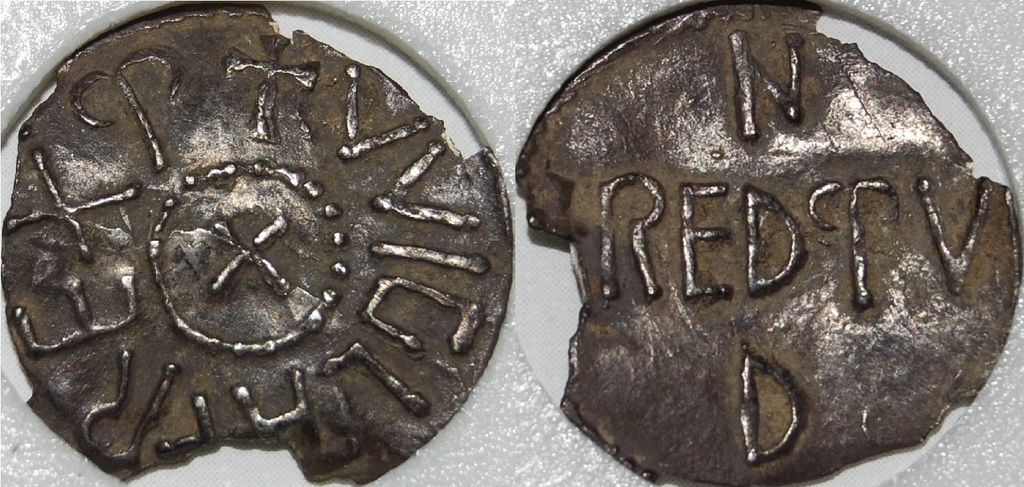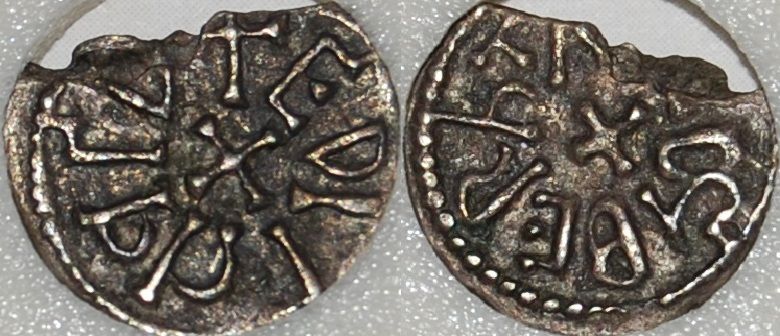Filling holes with damaged coins, Anglo-Saxon collection
 Nap
Posts: 1,761 ✭✭✭✭✭
Nap
Posts: 1,761 ✭✭✭✭✭
I am aware of the mantra in collecting that recommends buying the best coin one can afford, and avoiding damaged goods. This way of thinking has served collectors extremely well historically, and I believe it is a good guide for anyone getting involved in just about any series.
The more you delve into a series and specialized you become, however, there are some unfortunate problems. Especially with medieval and ancient coins, the goal of set completion is nearly always unattainable given that many varieties are unique or nearly so, or hoarded in museums. Most collectors of modest means will eventually have to choose between quality and comprehensiveness. Even if quality is occasionally sacrificed, one must still make choices when building a collection when you get to the scarcest of issues. Sometimes it is a matter of leaving a hole empty or filling it with an impaired specimen. Impaired specimens can include deliberate ancient damage (cut halfpenny, holes, scratching/etching), deliberate modern damage (cleaning, polishing, tooling), accidental damage (broken edges, surface porosity), and even manufacturing problems (off center strike, poor strike, small or poorly made planchet).
It's easier to "forgive" manufacturing problems or accidental damage, but damage is damage.
So here are two Anglo-Saxon coins which are both excessively rare (~5 specimens known in private hands). Both are damaged coins.
The first is a penny of Wiglaf, king of Mercia:

O: +VVIGLAF REX M
R: N +REDMV D
Wiglaf was king of Mercia 827-839. Despite a relatively long rule (compared to other 9th century Mercian kings), coins of Wiglaf are excessively rare. There are two major types, one with a portrait of the king by the moneyer Aethelhun, and a nonportrait type by the moneyers Burgherd and Redmund. Redmund also struck coins for King Ecgberht of Wessex when he occupied Mercia. The portrait coins are typically assigned to Wiglaf's first reign while the nonportrait type is given to the second reign, but this is a guess at best.
The second is a sceat of Aethelwald Moll, king of Northumbria:

O: +EDILhpLd
R: ECGBERhT A[R]
Aethelwald, a "shadowy king", was ruler of Northumbria 759-765. Surnames in Anglo-Saxon times were unusual, and the fact that this king has the surname Moll probably implies that he is not of royal descent. It is believed that Aethelwald was involved in the murder of his predecessor. Despite a rule of 6 years, coins in Aethelwald's name are excessively rare. Until quite recently, this coin was the only one known. It depicts the name of Aethelwald, with the archbishop Ecgberht's name on the reverse.
Both of these coins are obviously damaged, with pieces missing. The missing parts do not prevent the coins' identification, but do obviously impair their overall appearances.
I do not expect there to be generalized appreciation for these coins. They are not beautiful, and their designs are extremely uninteresting. Those that collect this series may appreciate the rarity, but even they understand these do not have broad appeal. To me however these are prized additions to my collection.
However, I'm sure I'm not alone in having damaged coins filling holes in a specialized collection. If you can relate, feel free to share your broken treasures, or opinion on the matter.
The more you delve into a series and specialized you become, however, there are some unfortunate problems. Especially with medieval and ancient coins, the goal of set completion is nearly always unattainable given that many varieties are unique or nearly so, or hoarded in museums. Most collectors of modest means will eventually have to choose between quality and comprehensiveness. Even if quality is occasionally sacrificed, one must still make choices when building a collection when you get to the scarcest of issues. Sometimes it is a matter of leaving a hole empty or filling it with an impaired specimen. Impaired specimens can include deliberate ancient damage (cut halfpenny, holes, scratching/etching), deliberate modern damage (cleaning, polishing, tooling), accidental damage (broken edges, surface porosity), and even manufacturing problems (off center strike, poor strike, small or poorly made planchet).
It's easier to "forgive" manufacturing problems or accidental damage, but damage is damage.
So here are two Anglo-Saxon coins which are both excessively rare (~5 specimens known in private hands). Both are damaged coins.
The first is a penny of Wiglaf, king of Mercia:

O: +VVIGLAF REX M
R: N +REDMV D
Wiglaf was king of Mercia 827-839. Despite a relatively long rule (compared to other 9th century Mercian kings), coins of Wiglaf are excessively rare. There are two major types, one with a portrait of the king by the moneyer Aethelhun, and a nonportrait type by the moneyers Burgherd and Redmund. Redmund also struck coins for King Ecgberht of Wessex when he occupied Mercia. The portrait coins are typically assigned to Wiglaf's first reign while the nonportrait type is given to the second reign, but this is a guess at best.
The second is a sceat of Aethelwald Moll, king of Northumbria:

O: +EDILhpLd
R: ECGBERhT A[R]
Aethelwald, a "shadowy king", was ruler of Northumbria 759-765. Surnames in Anglo-Saxon times were unusual, and the fact that this king has the surname Moll probably implies that he is not of royal descent. It is believed that Aethelwald was involved in the murder of his predecessor. Despite a rule of 6 years, coins in Aethelwald's name are excessively rare. Until quite recently, this coin was the only one known. It depicts the name of Aethelwald, with the archbishop Ecgberht's name on the reverse.
Both of these coins are obviously damaged, with pieces missing. The missing parts do not prevent the coins' identification, but do obviously impair their overall appearances.
I do not expect there to be generalized appreciation for these coins. They are not beautiful, and their designs are extremely uninteresting. Those that collect this series may appreciate the rarity, but even they understand these do not have broad appeal. To me however these are prized additions to my collection.
However, I'm sure I'm not alone in having damaged coins filling holes in a specialized collection. If you can relate, feel free to share your broken treasures, or opinion on the matter.
0
Comments
Congrats on the additions.
If you like these coins, then that is all that matters. Besides, they are crazy rare, and that is not nothing. The renowned Larry Stack collection of Anglo-Saxon pieces also had damaged lots. It's a necessary evil for this stuff.
Congrats on your acquisitions.
EVP
How does one get a hater to stop hating?
I can be reached at evillageprowler@gmail.com
1788 (P-940) pattern halfpenny in PF61, with lots of obvious hairlines. But, I currently know of 2 existing, this and one in the British Museum collection. Peck listed this piece as Excessively Rare with 2 observed pieces.
Luckily for me there isn't a huge collector base for these, so prices are still extremely reasonable.
World Collection
British Collection
German States Collection
I am waiting on grades right now, knowing that 1 of the coins will be body bagged. Couldn't be happier about it. This particular tough variety will finally complete my first set, out of the various 8 Reales sets I've been working on for the past 10 years.
I can certainly relate to the difficult choice of rarity vs condition. Many coins of Isabel II are extremely difficult to find without problems.
Wonder if that is also done with rare coins ?
The Sceat is an interesting piece. As you are presumably aware it was lot 58 in the recent Stewartby sale. The footnote to the lot states that Lyon propsed the name was that of Alchred rather than than Aethelwald, but tbh, it all depends on how you read it. On the assumption that the legend starts at the + (which is not always the case), then clockwise favours Aethelwald whilst retrograde would pass for Alchred as seen. The variable literacy standards of the engravers ensures the academics will find employment for decades to come.
The waters are somewhat clarified by Tony Abramson who illustrates a coin from the same questioned die as under Athelwald Moll, assisted in no small part by the letter to the left of the cross as a D. The truth is, nobody is certain, but looking at the historical chronology, Athelwald was deposed by Alchred in 765, and in turn the latter was deposed by Athelwald's son, Ethilred in 774. Given there are sceats with an unambiguous Alchred reading, and an issue that's fairly conclusively in the joint names of Athelwald R and Ethilred R, I would lean towards an Athelwald attribution.
I'm aware of the Athelwald sceat's history, as I did purchase it out of the Stewartby sale. The coin itself has an extensive provenance, and was first published in the 1840s by Rev. Dymock. Rashleigh and Grantley followed with their opinion that the coin did belong to Aethelwald. Mr. Lyon did originally think the coin to be a variety in the name of Alchred in his artcile in BNJ 28 (1955), which Spink quoted both in the Stewartby catalog, and also in their sale of the Firth collection in 1978. What they did not mention is that Mr. Lyon himself changed his opinion, in his "President's Address" in the 1967 BNJ 36, where he states he believes it is a coin of Aethelwald. Other researchers have taken similar approaches, such as James Booth, who initially doubted an attribution to Aethelwald (Sceattas in Northumbria, 1984) but also changed his opinion later (Notes on the Keith Chapman collection of Northumbrian silver sceattas, 2011).
Here is one of the two others known, a complete coin sold by CNG: Link here
This coin has a similar obverse die to my example, but it is not identical. The reverse die looks to be the same as mine.
As Rob mentioned, King Aethelwald's successor in Northumbria, a king named Alchred, also issued similar-looking sceats with Archbishop Ecgbert. These coins are fairly rare, as Ecgberht died a year into Alchred's reign, but there are at least a few dozen specimens. While Alchred's name often appears rather "funky" (such as this coin), there is always a clear AL and an HR (frequently are retrograde), devices that are not present on my coin.
Lord Stewartby himself wrote an article regarding his coin's attribution (A Northumbrian coin of King Ethelwald and Archbishop Ecgberht, 1991). He was fairly unequivocal that it was not a coin of Alchred. Of course, ownership adds that bias.
As for me, I too believe it is a coin of Aethelwald.